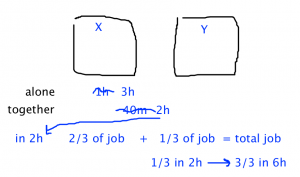-
Target Test Prep 20% Off Flash Sale is on! Code: FLASH20
Redeem
GMAT Prep Story Problem: Make It Real
 In the past, weve talked about making story problems real. In other words, when the test gives you a story problem, dont start making tables and writing equations and figuring out the algebraic solution. Rather, do what you would do in the real world if someone asked you this question: a back-of-the-envelope calculation (involving some math, sure, but not multiple equations with variables).
In the past, weve talked about making story problems real. In other words, when the test gives you a story problem, dont start making tables and writing equations and figuring out the algebraic solution. Rather, do what you would do in the real world if someone asked you this question: a back-of-the-envelope calculation (involving some math, sure, but not multiple equations with variables).
If you havent yet read the article linked in the last paragraph, go do that first. Learn how to use this method, then come back here and test your new skills on the problem below.
This is a GMATPrep problem from the free exams. Give yourself about 2 minutes. Go!
* Machines X and Y work at their respective constant rates. How many more hours does it take machine Y, working alone, to fill a production order of a certain size than it takes machine X, working alone?(1) Machines X and Y, working together, fill a production order of this size in two-thirds the time that machine X, working alone, does.
(2) Machine Y, working alone, fills a production order of this size in twice the time that machine X, working alone, does.
You work in a factory. Your boss just came up to you and asked you this question. What do you do?
In the real world, youd never whip out a piece of paper and start writing equations. Instead, youd do something like this:
I need to figure out the difference between how long it takes X alone and how long it takes Y alone.
Okay, statement (1) gives me some info. Hmm, so if machine X takes 1 hour to do the job by itself, then the two machines together would take two-thirdslets see, thats 40 minutes
Wait, that number is annoying. Lets say machine X takes 3 hours to do the job alone, so the two machines take 2 hours to do it together.
What next? Oh, right, how long does Y take? If they can do it together in 2 hours, and X takes 3 hours to do the job by itself, then X is doing 2/3 of the job in just 2 hours. So Y has to do the other 1/3 of the job in 2 hours.
If Y does 1/3 of the job in 2 hours, it can do the whole job in 6 hours.
6 hours for Y 3 hours for X = 3 hours
Now, if this had been a Problem Solving question where you could use Smart Numbers, youd pretty much be done. But its data sufficiency. Could you pick different numbers that would still work but give a different answer?
Sure. Double everything. If X takes 6 hours alone, then the two machines would take 4 hours together. Machine X would still do 2/3 of the job in that time, so Machine Y would still do 1/3, and therefore Machine Y could do the whole job in 12 hours. (You dont, of course, have to take the calculation this far. Stop when you know that the calculation can be done.)
Statement (1) is not sufficient. Cross off answers (A) and (D).
Try the same process for statement (2).
Whenever youre testing cases (using real numbers to see how the scenario would play out), try to re-use the numbers that you already used for the first statement, if possible.
Case 1: X = 3 hours alone, Y = 6 hours alone
Can I use this for statement (2)? Definitely! It actually says that Y takes twice the time of X, so this works perfectly! I already know that these numbers will give one answer, and then
Case 2: X = 6 hours alone, Y = 12 hours alone
this one also fits but gives a different answer. (Note: If you hadn't completed the math during statement (1), you'd need to complete it now to see that when X = 6, Y = 12.)
Great! Statement (2) is not sufficient either.
Cross off answer (B). Now, you can revel in the beauty of trying the same numbers for both statements: youve already evaluated the two statements together as well! Even when used together, the two statements yield multiple possible answers to the question, so none of the given information is sufficient to answer the question.
The correct answer is (E).
Key Takeaways: Make Stories Real
(1) Put yourself in the problem. If someone really asked you to figure out this scenario as part of your job, you wouldnt whip out a piece of paper and start jotting down equations. Youd plug in some real numbers and logic it out.
(2) Some problems allow for multiple possible scenariosData Sufficiency problems in general as well as Problem Solving must be true questions. When you get one of these, test different cases to see whether you can get contradictory answers. If so, that statement is not sufficient.
(3) When testing cases for the second statement, think about what you tried for the first statement. Whenever possible, re-use the same numbers (check to ensure that the numbers are allowed by the second statement!). This way, if you eventually have to test the two statements together, some of your work is already done for you.
* GMATPrep questions courtesy of the Graduate Management Admissions Council. Usage of this question does not imply endorsement by GMAC.
Recent Articles
Archive
- April 2024
- March 2024
- February 2024
- January 2024
- December 2023
- November 2023
- October 2023
- September 2023
- July 2023
- June 2023
- May 2023
- April 2023
- March 2023
- February 2023
- January 2023
- December 2022
- November 2022
- October 2022
- September 2022
- August 2022
- July 2022
- June 2022
- May 2022
- April 2022
- March 2022
- February 2022
- January 2022
- December 2021
- November 2021
- October 2021
- September 2021
- August 2021
- July 2021
- June 2021
- May 2021
- April 2021
- March 2021
- February 2021
- January 2021
- December 2020
- November 2020
- October 2020
- September 2020
- August 2020
- July 2020
- June 2020
- May 2020
- April 2020
- March 2020
- February 2020
- January 2020
- December 2019
- November 2019
- October 2019
- September 2019
- August 2019
- July 2019
- June 2019
- May 2019
- April 2019
- March 2019
- February 2019
- January 2019
- December 2018
- November 2018
- October 2018
- September 2018
- August 2018
- July 2018
- June 2018
- May 2018
- April 2018
- March 2018
- February 2018
- January 2018
- December 2017
- November 2017
- October 2017
- September 2017
- August 2017
- July 2017
- June 2017
- May 2017
- April 2017
- March 2017
- February 2017
- January 2017
- December 2016
- November 2016
- October 2016
- September 2016
- August 2016
- July 2016
- June 2016
- May 2016
- April 2016
- March 2016
- February 2016
- January 2016
- December 2015
- November 2015
- October 2015
- September 2015
- August 2015
- July 2015
- June 2015
- May 2015
- April 2015
- March 2015
- February 2015
- January 2015
- December 2014
- November 2014
- October 2014
- September 2014
- August 2014
- July 2014
- June 2014
- May 2014
- April 2014
- March 2014
- February 2014
- January 2014
- December 2013
- November 2013
- October 2013
- September 2013
- August 2013
- July 2013
- June 2013
- May 2013
- April 2013
- March 2013
- February 2013
- January 2013
- December 2012
- November 2012
- October 2012
- September 2012
- August 2012
- July 2012
- June 2012
- May 2012
- April 2012
- March 2012
- February 2012
- January 2012
- December 2011
- November 2011
- October 2011
- September 2011
- August 2011
- July 2011
- June 2011
- May 2011
- April 2011
- March 2011
- February 2011
- January 2011
- December 2010
- November 2010
- October 2010
- September 2010
- August 2010
- July 2010
- June 2010
- May 2010
- April 2010
- March 2010
- February 2010
- January 2010
- December 2009
- November 2009
- October 2009
- September 2009
- August 2009
